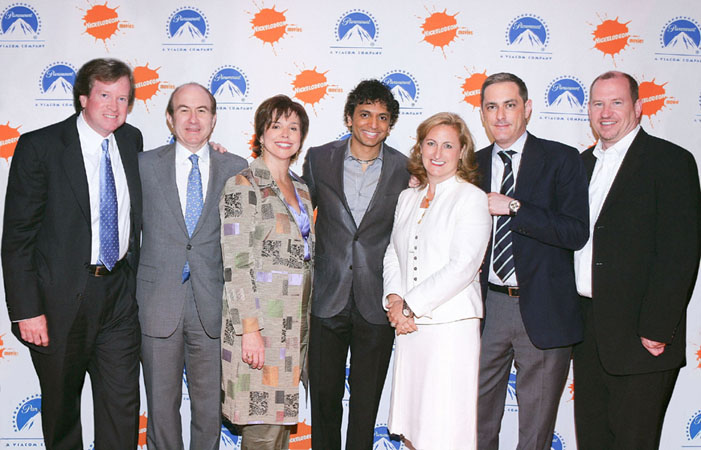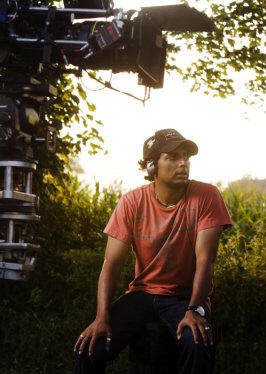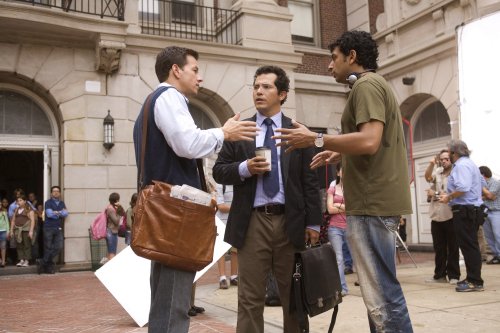Like his work
or not, director M. Night Shyamalan employs big ideas and challenges
himself and his viewers with unusual and dark storylines with the
framework to express them. After his incredible success with The
Sixth Sense, Unbreakable and Signs, he was hailed as a
youthful wunderkind with a special skill at fashioning supernatural
thrillers with a twist. Rightly or wrongly, he was saddled with the
idea that his films always had to have a trick ending, a secret to
be revealed, and each film needed to be marketed in the same way.
But then his last couple of films under-performed spectacularly, and
Shyamalan was chastened. So when he landed at Fox with his recent
summer film, The Happening, he was under scrutiny of the
studio.
Although known
as a purveyor of big-budgeted genre pictures, Shyamalan was able to
make The Happening for a relatively modest budget
(approximately $30 million) with a cast of quality actors who don't
necessarily draw in the tentpole audiences. Yet, despite the
pressure to perform, Shyamalan has made one strange film.
One thing this
37-year old Indian-born writer/director understands is that by
basing his films on the realm of fantasy, science fiction, and the
supernatural he draws the mythological aura these genres suggest.
Like Stephen King, Shyamalan tells stories filled with ordinary
middle class people thrown into very bizarre, life-threatening
situations that test their ability to grasp consensus reality and
find solutions.
In this case,
planetary vegetation has somehow reacted to our civilization as an
ecological threat and developed a suicide inducing pheromone that
gets released near large populations. Almost as if the flora has
joined forces to express a warning, certain heavily populated areas
of the East Coast are plagued by a lemming-like wave of gruesome
deaths, starting with an opening sequence weirdly reminiscent of
actual scenes of 9/11 death leaps.
Into this
scenario comes his key cast members Mark Wahlberg (Elliot), John
Leguizamo (Julian), and Zooey Deschanel (Alma) who grapple with
this frightening and unexplainable situation. Once exposed to these
suicides, this trio, and Julian's daughter, try to escape the cities
and survive by isolating themselves from society at large.
Shyamalan
discussed this and more in a recent session before several
journalists.
 How
does this storyline reflect your worldview?
How
does this storyline reflect your worldview?
You know, all
these movies, they're all a little bit like therapy about
something that's bothering me or family things. I'm always working
them in, in a journal-like way. But [this film] does represent
things that are on my mind [right now]. I think everybody in our
generation is starting to worry about these types of things.
Certainly in an election year, you think about the future. It's
interesting, this slew of end-of-the-world movies. There's an
anxiety that's in the air, and it sort of mimics the '50s, the same
kinds of anxieties that were about our future. Where are we headed?
Are we going in the right direction? Is it too late to change
course? [I had that] all in the back of my head. I never thought I
was actually all that serious a person. But when I sit down to
write, I guess more adult things come out.
Born in India,
a transplanted South Asian of Hindu descent, your non-western
experiences seems to have influenced you. Plants having a
consciousness is a non-western world view; is that part of the
spiritual side to this film?
Definitely.
It's interesting because of the Native American culture that's all
it's about. My middle name, Night, it's an American Indian name.
That is what I felt so attached to when I was a kid from the
American Indian culture the relationship to nature, and
worshipping the sky, the earth, and the rocks. As a kid, that
relationship felt correct, and it feels correct now as an adult.
It's interesting how in all our religions so little is said about
how we should feel towards nature. It's an interesting thing to kind
of get the hierarchy back in line. We're just one of many living
creatures on the planet. I had this conversation [with some of the
cast]. They asked, "What were you thinking about?" I said, "Jesus."
They said, "What?!"
Your main
protagonist, a science teacher, is discussing limits of rational
thought by the end of the film...
Well, I was
reading the Einstein biography when I was writing the screenplay. I
don't know if you've read it. It's just fantastic. The new one by
Walter Isaacson [Einstein: His Life and Universe (2007)] is a
beautiful, beautiful book. One of the things I was struck by and
when you read the book you may not even see that it's in there, but
I saw it there was that Einstein was this guy [who first] rejected
religion and became atheistic, did his wondrous things in his 20s,
and got really into it. Then in the gaps in science he started
seeing a hand, you know? In his point of view, the hand of God. A
divine kind of "Is there something there?" His life struggle was
finding an overall formula, an overall thing that could define the
design of things, and a belief that it was there. Then he became
very religious. The ultimate man of science became a man of faith.
In a way, when I was writing Elliot [played by Mark Wahlberg], it
affected Elliot. He's just a high school science teacher. He has
plenty of gaps in his knowledge of science. I said, "You're just a
regular science teacher. You're not going to be the hero that
figures out something. It's not like that. But you see in those
gaps
" He honors those things in the gap. That's why it felt like
Mark was the right casting, because obviously he's a man of faith.
Because there are things that we don't know. The lack of need to
define it in the closest category is something inspiring when I see
that in somebody, whether it's Einstein or Elliot's character or
Mark. And so it is a question of science to almost give evidence to
something else.
 You
have a math teacher, a science teacher and his psychologist wife a
playing these roles...?
You
have a math teacher, a science teacher and his psychologist wife a
playing these roles...?
The movie's
really about the state of where we are now in the world the
paranoia, how we feel toward strangers, to each other, to other
countries, to everything in the sense that we don't trust anybody. I
was saying that Mrs. Jones is the ultimate version of that character
if she kept on going, she would close off everything and distrust
everybody. So we went that way in talking about her. Really, that's
the part of me that wants to protect myself, and jokes about it, and
tries to undermine it. But it's really a delicate thing for me to
go, "It's better to protect myself. Let me protect myself like
everybody else is protecting themselves." Which is exactly the
opposite of what I tell my kids. I tell them, "Be completely
vulnerable. Take every hit you can because that'll allow you to feel
all those great things that are going to come love, joy,
creativity all that stuff. It will always outweigh the amount of
hits you're going to get. Although you want to protect yourself from
those little hits. Really, the struggle of the movie was her
struggle which is my struggle which is, "Is this person an
appropriate way to be?" Which is the way I am naturally. "Is this an
appropriate way to be, or is this the right way to be?" The struggle
of whether to question it or not.
John's
character is
the guy with the numbers. It always comforts me to
give numbers: "There's a 34% chance that we're going to be okay."
Again, in many ways, they're similar, because he sees beauty in math
as well. So when he tells that story when they're dying in the jeep
he tells that beautiful riddle and says, "If you just double that
penny at the end of the month you'll have over $10 million." It's
amazing, the properties of math. And he tries one last time to teach
this girl in the jeep [who is freaking out], "Isn't math wondrous?
Do you want to hear one more story about it?" Again, they each see
something kind of bigger in their fields. Whereas Alma's the person
deciding whether the world is that way, or if it's really a kind of
crappy place. Literally, it was an agenda. I know this sounds silly,
but I wanted to put the most likable cast that I could possibly put
at the center or the movie. You can get a great actor, but if they
come from a dark place, and then if you put them at the center of
this dark movie, the movie would just become unbearable. [This cast]
all comes from a place they don't know why they do it, but that's
their gift they come from a place of light, all three of them. And
to put those guys, and all the rest of the cast even Betty
Buckley, who chose to play Mrs. Jones trying to have light... And
then it just messes up. A whole cast of actors coming from light was
right at the center. That's why the movie, even though it's so dark,
has such a great light to it. When I wrote the characters, they all
had some aspects of me, of things I was struggling with or thinking
about. Zooey's character is the person that's scared to be
vulnerable. They're all scared to be vulnerable, and use humor to
deflect that feeling of "I don't want to risk myself."
 Is it possible
to make a popcorn flick with a serious and important message?
Is it possible
to make a popcorn flick with a serious and important message?
Yeah,
definitely. One of the things that I said to everybody, the cast and
crew, "This is a B-movie here. Let's get ourselves straight here.
This is just a grade B movie. We're making the best B movie that we
can here, that's our job. If the movie has something that sticks
with you, great. But we're not going to put that in front of the
movie. We're going to have a lot of fun. It's a paranoia movie. We
just need to pound away. That's our job." I was really clear about
that. So in that way, it was meant to be entertainment. I think one
reporter asked, "How come you just don't go make a pure popcorn
movie and then go make your art movie? It seems like you want to do
[both in one film]." The problem is that both are my instincts, to
have one [foot] in each place, which sometimes pisses off one group
and sometimes pisses off the other group. My wife says, "Just make
one or the other." I wish I could, but as it ends up, I think about
all these kinds of spiritual things. And I do love cheeseburgers and
I do Seinfeld and I do love Coca-Cola and I do love Michael
Jordan. It's just me. So if I took one side away the side that
really loves to read about philosophy and pretend that side didn't
exist, it would be a lie. And if I pretended I wasn't jumping up and
down watching the Celtics last night, that would be a lie as well.
So it's that balancing act. I keep trying to be honest here.
To
get that mix, this film got an R rating.
I got an R on
two other movies on The Sixth Sense and The Village.
I got an R initially, for the intensity of certain scenes. We were
right on the line, and I could always just pull back and resubmit it
so they go, "Oh, that's much better." All I did was take out some
sound effects. It's always the impact; the emotion was different
than what I actually showed. But this one, with the screenplay I
wrote, there was just no way to do it any other way. One of the
movies I was thinking about was Pan's Labyrinth. I was
thinking about it a lot when I made the decision, because I didn't
want to make it as an agenda. You want to make an organic decision
about what does the material want to do. And when I thought about
Pan's Labyrinth which had visceral moments of violence
juxtaposed against the softer things that are going on against the
canvas it gave it authority and some teeth. For me, a PG-13
version of Pan's Labyrinth wouldn't have had that kind of
impact. It wouldn't have stayed with me the way that movie has
stayed with me. And so it felt like the right balance of things. It
was exciting, and it was disturbingly easy to shoot all those
scenes. I had such a fun time.
What are your
greatest fears in real life?
I've changed
my thinking, and my analysis of fear has come down to the factor of
being alone. It's all based on versions of that. Take random things
that you're scared of
"I'm scared to fly" or you're scared of the
new job that you have. It's all related to the feeling of "I'm going
to have emotions, and no one else will have those emotions. I'll be
alone in some manner." So if you're scared of flying but if you talk
to the pilot or talk to somebody else, you don't feel as scared.
It's the human connection. You're not alone anymore, you have
commonality. And I've said that art, I believe, is the ability to
convey that we're not alone. That's the power of art. It's always
been in our genetics, since we were cave people. Fear protects us
"Don't go down that road, you'll be alone. We don't know what's down
that road. You'll be alone. Being alone is not good. Together we're
safer." And the person that didn't have that [reaction], didn't
survive, right? Now it's flipped on us and become a limiting factor.
We're scared to put our kids in the backyard now because our
neighbors might do something. But our neighbors are wonderful
people; the assumption is wrong. It's the same that it was when I
was a kid running around on a bike. We're so much more scared now,
but nothing has changed. Nothing has changed, except for fear. And
the fear builds on itself, because we get more and more isolated
like Mrs. Jones, until your fear has been realized you're all
alone.